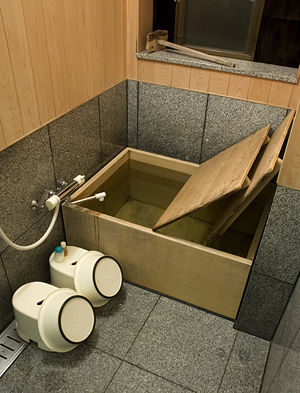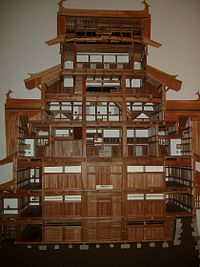- Furo
-
For furo (風炉), the hearth used in Japanese tea ceremony, see List of Japanese tea ceremony equipment#Hearths.
Furo (風呂), also known in the polite form as ofuro (お風呂), is Japanese for bath. Specifically it is used to refer to a type of bath which originated as a short, steep-sided wooden bathtub. Baths of this type are found all over Japan in houses, apartments and traditional Japanese inns (Ryokans) but are now usually made out of a plastic or stainless steel.
A furo differs from a conventional western bathtub by being of a deeper construction, typically in the region of 0.6 m (25 inches). The sides are generally square rather than being sloped. They generally have no overflow drainage. Traditional pot shaped cast iron furo were heated by a wood-burning stove built-in below them.
Furo (or Yubune (湯船) that specifically refer to the bath with water) are usually left filled with water overnight, and for some household the water reused or recycled for washing clothes the next day. As in the West, it was the custom for more than one member of the family to use the same bath water and therefore, for the Japanese, it was important to be completely clean before entering the bath. This type of furo was the precursor of the modern western-style hot tub.[citation needed]
Furo are part of the Japanese ritual of bathing, not meant for washing but rather for relaxing and warming oneself. Washing is carried out separately outside the yubune. The bather should enter the water only after rinsing or lightly showering. Generally Japanese bathrooms are quite small compared to western standards, so the bathroom is set up much like a walk-in shower area but containing the furo. Since the bathroom is a complete wet-area, in modern buildings and Ryokan heating is provided by air conditioners overhead. The water is hot, usually approximately 100 to 108 degrees F (38 to 42 degrees Celsius).
A Modern furo may be made of acrylic, and the top of the range models fitted with a re-circulation system which filters and re-heats the water. This system is connected with the hot water heater, either for gas/propane fired or electric/heat-pump types. Luxury models are still made out of traditional or expensive woods like hinoki, and can be retrofitted with Western style fittings and used as signature pieces by architects and interior designers internationally.
See also
External links
- Japanese Guest Houses: Japanese Bathing Etiquette
- Ofuro Etiquette
- Different shapes and sizes of ofuro made in hinoki wood
- SentoGuide: A guide to public baths in Japan
Elements of Japanese architecture Styles Buddhist · Buke · Daibutsuyō · Gassho · Giyōfū · Hachiman · Hirairi · Hiyoshi (also called Hie) · Irimoya · Ishi-no-ma · Kasuga · Kibitsu · Nagare · Ōbaku Zen · Setchūyō · Shinden · Shinmei · Shinto · Shoin · Sukiya · Sumiyoshi · Taisha · Wayō · ZenshūyōBuilding types Roof styles Structural Burdock piling · Chigi · Disordered piling · Engawa · Fusuma · Hisashi · Irimoya-zukuri · Irori · Jinmaku · Katōmado · Katsuogi · Kuruwa · Mokoshi · Moya · Nakazonae · Namako wall · Nightingale floor · Onigawara · Ranma · Shōji (see also washi) · Sōrin · Tamagaki · Tatami · Tokonoma · Tokyō · Tsumairi · ShibiGates and approaches Rooms Furnishings Outdoor objects Measurements Groups See also Categories:- Bathing in Japan
- Japanese home
- Japan culture stubs
- Architecture stubs
Wikimedia Foundation. 2010.



